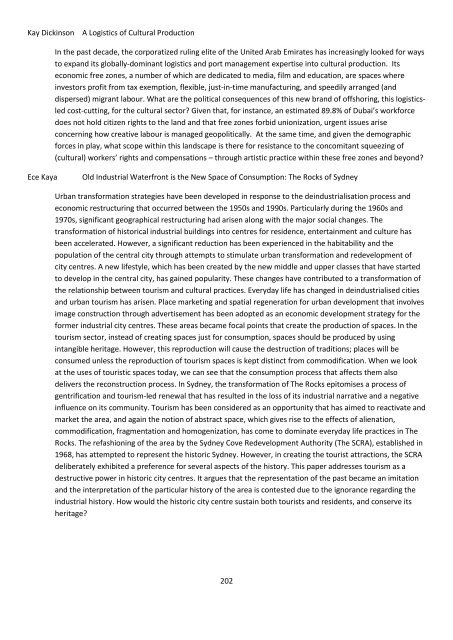Crossroads in Cultural Studies Conference 14-17th December 2016 Program Index
Crossroads-2016-final-draft-program-30-Nov
Crossroads-2016-final-draft-program-30-Nov
You also want an ePaper? Increase the reach of your titles
YUMPU automatically turns print PDFs into web optimized ePapers that Google loves.
Kay Dick<strong>in</strong>son<br />
A Logistics of <strong>Cultural</strong> Production<br />
In the past decade, the corporatized rul<strong>in</strong>g elite of the United Arab Emirates has <strong>in</strong>creas<strong>in</strong>gly looked for ways<br />
to expand its globally-dom<strong>in</strong>ant logistics and port management expertise <strong>in</strong>to cultural production. Its<br />
economic free zones, a number of which are dedicated to media, film and education, are spaces where<br />
<strong>in</strong>vestors profit from tax exemption, flexible, just-<strong>in</strong>-time manufactur<strong>in</strong>g, and speedily arranged (and<br />
dispersed) migrant labour. What are the political consequences of this new brand of offshor<strong>in</strong>g, this logisticsled<br />
cost-cutt<strong>in</strong>g, for the cultural sector? Given that, for <strong>in</strong>stance, an estimated 89.8% of Dubai’s workforce<br />
does not hold citizen rights to the land and that free zones forbid unionization, urgent issues arise<br />
concern<strong>in</strong>g how creative labour is managed geopolitically. At the same time, and given the demographic<br />
forces <strong>in</strong> play, what scope with<strong>in</strong> this landscape is there for resistance to the concomitant squeez<strong>in</strong>g of<br />
(cultural) workers’ rights and compensations – through artistic practice with<strong>in</strong> these free zones and beyond?<br />
Ece Kaya<br />
Old Industrial Waterfront is the New Space of Consumption: The Rocks of Sydney<br />
Urban transformation strategies have been developed <strong>in</strong> response to the de<strong>in</strong>dustrialisation process and<br />
economic restructur<strong>in</strong>g that occurred between the 1950s and 1990s. Particularly dur<strong>in</strong>g the 1960s and<br />
1970s, significant geographical restructur<strong>in</strong>g had arisen along with the major social changes. The<br />
transformation of historical <strong>in</strong>dustrial build<strong>in</strong>gs <strong>in</strong>to centres for residence, enterta<strong>in</strong>ment and culture has<br />
been accelerated. However, a significant reduction has been experienced <strong>in</strong> the habitability and the<br />
population of the central city through attempts to stimulate urban transformation and redevelopment of<br />
city centres. A new lifestyle, which has been created by the new middle and upper classes that have started<br />
to develop <strong>in</strong> the central city, has ga<strong>in</strong>ed popularity. These changes have contributed to a transformation of<br />
the relationship between tourism and cultural practices. Everyday life has changed <strong>in</strong> de<strong>in</strong>dustrialised cities<br />
and urban tourism has arisen. Place market<strong>in</strong>g and spatial regeneration for urban development that <strong>in</strong>volves<br />
image construction through advertisement has been adopted as an economic development strategy for the<br />
former <strong>in</strong>dustrial city centres. These areas became focal po<strong>in</strong>ts that create the production of spaces. In the<br />
tourism sector, <strong>in</strong>stead of creat<strong>in</strong>g spaces just for consumption, spaces should be produced by us<strong>in</strong>g<br />
<strong>in</strong>tangible heritage. However, this reproduction will cause the destruction of traditions; places will be<br />
consumed unless the reproduction of tourism spaces is kept dist<strong>in</strong>ct from commodification. When we look<br />
at the uses of touristic spaces today, we can see that the consumption process that affects them also<br />
delivers the reconstruction process. In Sydney, the transformation of The Rocks epitomises a process of<br />
gentrification and tourism-led renewal that has resulted <strong>in</strong> the loss of its <strong>in</strong>dustrial narrative and a negative<br />
<strong>in</strong>fluence on its community. Tourism has been considered as an opportunity that has aimed to reactivate and<br />
market the area, and aga<strong>in</strong> the notion of abstract space, which gives rise to the effects of alienation,<br />
commodification, fragmentation and homogenization, has come to dom<strong>in</strong>ate everyday life practices <strong>in</strong> The<br />
Rocks. The refashion<strong>in</strong>g of the area by the Sydney Cove Redevelopment Authority (The SCRA), established <strong>in</strong><br />
1968, has attempted to represent the historic Sydney. However, <strong>in</strong> creat<strong>in</strong>g the tourist attractions, the SCRA<br />
deliberately exhibited a preference for several aspects of the history. This paper addresses tourism as a<br />
destructive power <strong>in</strong> historic city centres. It argues that the representation of the past became an imitation<br />
and the <strong>in</strong>terpretation of the particular history of the area is contested due to the ignorance regard<strong>in</strong>g the<br />
<strong>in</strong>dustrial history. How would the historic city centre susta<strong>in</strong> both tourists and residents, and conserve its<br />
heritage?<br />
202


